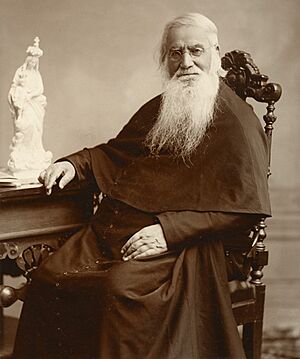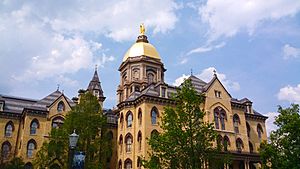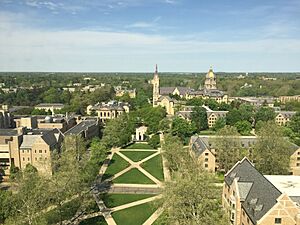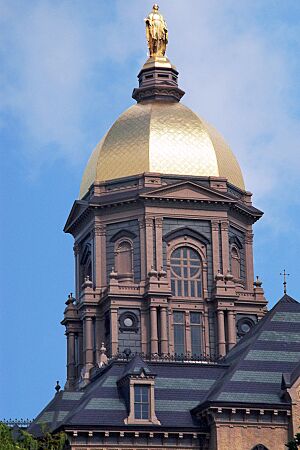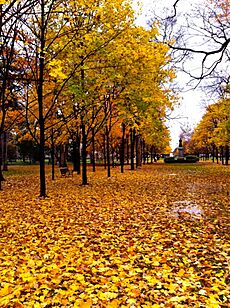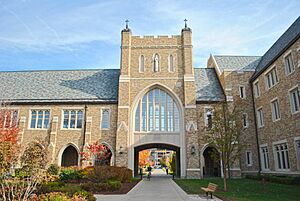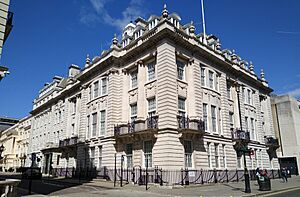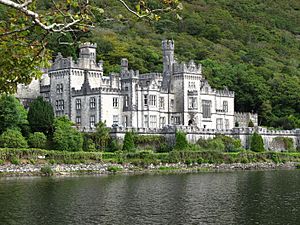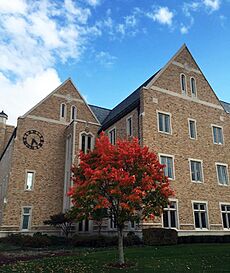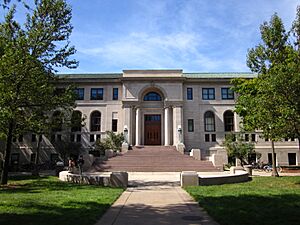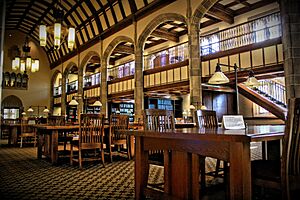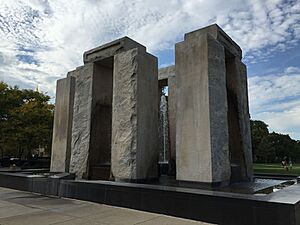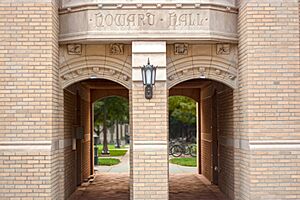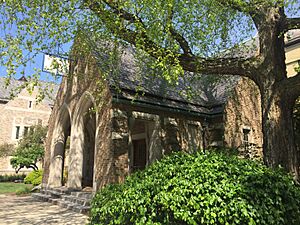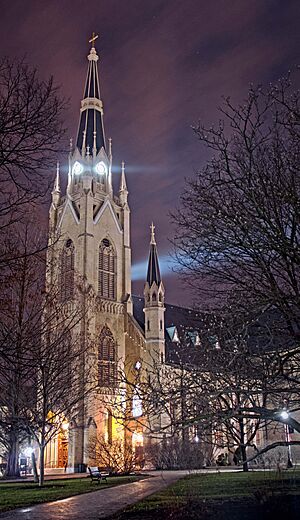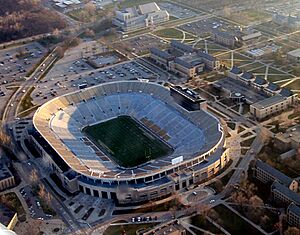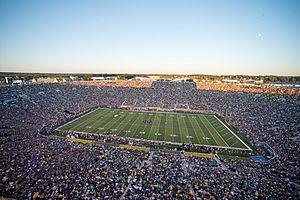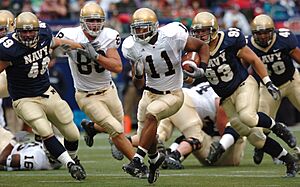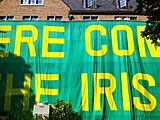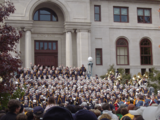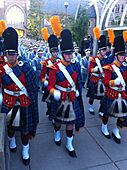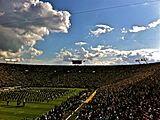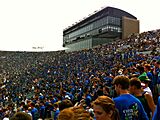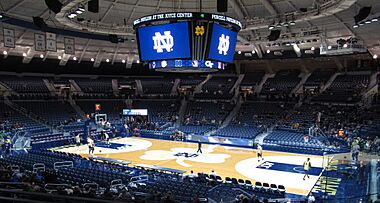University of Notre Dame facts for kids
 |
|
| Latin: Universitas Dominae Nostrae a Lacu | |
| Motto | Vita Dulcedo Spes (Latin) |
|---|---|
|
Motto in English
|
"Life, Sweetness, Hope" |
| Type | Private research university |
| Established | November 26, 1842 |
| Founder | Edward Sorin |
| Accreditation | HLC |
|
Religious affiliation
|
Roman Catholic (Congregation of Holy Cross) |
|
Academic affiliations
|
|
| Endowment | $16.62 billion (2023) |
| Budget | $1.8 billion (2023–2024) |
| President | Robert A. Dowd |
| Provost | John McGreevy |
|
Academic staff
|
1,526 (fall 2023) |
| Students | 13,174 (fall 2023) |
| Undergraduates | 8,968 (fall 2023) |
| Postgraduates | 4,206 (fall 2023) |
| Location |
,
Indiana
,
United States
41°42′00″N 86°14′20″W / 41.70000°N 86.23889°W |
| Campus | Large suburb, 1,261 acres (5.10 km2) |
| Newspapers |
|
| Colors | Blue and gold |
| Nickname | Fighting Irish |
|
Sporting affiliations
|
|
| Mascot | Leprechaun |
 |
|
The University of Notre Dame du Lac, often called Notre Dame, is a private Catholic university in Notre Dame, Indiana, USA. It was started in 1842 by a group of Catholic priests and brothers called the Congregation of Holy Cross. The main campus is quite large, covering 1,261 acres (about 510 hectares), and has famous buildings like the Golden Dome, the Sacred Heart Basilica, and the Grotto of Our Lady of Lourdes.
Notre Dame is known as a "Very High Research Activity" university, meaning it does a lot of important research. It has seven main schools and colleges, including ones for arts, science, law, architecture, engineering, business, and global affairs. The university also offers many advanced degrees for students who want to study even more after their first degree.
The university's sports teams are called the Fighting Irish. They compete in NCAA Division I and are especially famous for their football team. This team helped Notre Dame become well-known across the country in the early 1900s. Notre Dame teams have won many national championships in various sports.
Big improvements happened at Notre Dame between 1952 and 1987, when Theodore Hesburgh was president. During his time, the university grew a lot in its resources, academic programs, and overall reputation. Notre Dame also has a huge network of over 151,000 former students, called alumni.
Contents
History of Notre Dame
How Notre Dame Started
The land where Notre Dame stands was bought in 1830 by Stephen Badin, the first priest ordained in the United States. He was invited by a local chief, Leopold Pokagon, to help his tribe. In 1842, the bishop of Vincennes offered this land to Edward Sorin from the Congregation of Holy Cross. The only condition was that Sorin had to build a college there within two years.
Sorin arrived on November 26, 1842, with eight Holy Cross brothers from France and Ireland. They started the school using Badin's old log chapel. Soon, they built more buildings, including the first main building. Notre Dame began as a school for younger students, but in 1844, it officially became a college called the University of Notre Dame du Lac (University of Our Lady of the Lake). At first, only boys could attend. The Sisters of the Holy Cross then started Saint Mary's College nearby in 1844, which was only for girls.
Early Years and Growth
The college gave out its first degrees in 1849. As it grew, new study programs were added, and more buildings were constructed. A larger main building was built between 1865 and 1866. This building held the university's offices, classrooms, and student living areas.
Under William Corby's leadership, the number of students grew to over 500. In 1869, he opened the law school. In 1871, construction began on the Sacred Heart Church, which is now the Basilica of the Sacred Heart. Two years later, a library was started in the Main Building, which had 10,000 books by 1879.
However, a fire destroyed the Main Building and the library in April 1879. The school closed, and students went home. Rebuilding started quickly, and the current Main Building was finished before the fall semester of 1879. The library collection was also rebuilt.
During Thomas E. Walsh's time as president (1881–1893), Notre Dame worked to improve its academic reputation. He started new programs and invited important thinkers to campus. Washington Hall was built in 1881 as a theater, and the Science Hall (now the LaFortune Student Center) was built in 1883 for science classes. Sorin Hall was the first separate building for students to live in, with private rooms. During this time, Notre Dame also started its football program.
Becoming a Research University
John Zahm helped lead the Holy Cross order in the U.S. from 1898 to 1906. He wanted to make Notre Dame a modern university focused on research. He built new buildings and added to the campus art gallery and library. However, some worried he was expanding too fast and causing debt.
Later, John W. Cavanaugh continued the effort to make Notre Dame a strong academic university. He improved teaching standards and brought in many smart scholars. He also started a journalism program and chemical engineering courses. During his time, Notre Dame's football team became very successful. In 1917, Notre Dame gave its first degree to a woman, and its first bachelor's degree to a woman in 1922. However, it was not common for women to be undergraduate students until 1972.
James A. Burns became president in 1919. He made big changes to the academic system, bringing the school up to national standards. Notre Dame kept growing, adding more colleges, programs, and sports teams. By 1921, with the addition of the College of Commerce, Notre Dame had grown from a small college to a university with five colleges and a law school.
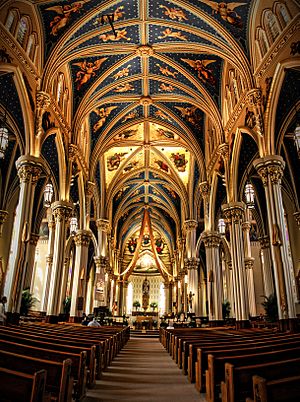
President Matthew J. Walsh (1922–1928) focused on building more dorms because many students lived off campus. He built several new residence halls, and by 1925, enrollment had grown to 2,500 students. He also expanded the College of Commerce and the stadium.
One of the biggest reasons for the university's growth was its football team, the Notre Dame Fighting Irish. Knute Rockne became head coach in 1918. Under him, the team won three national championships and had five seasons without any losses. They also won the Rose Bowl Game in 1925. Rockne is known for having the highest winning percentage in NCAA Division I/FBS football history.
The success of Notre Dame's football team showed the growing importance of Irish Americans and Catholics in the 1920s. People cheered for the team, especially when it beat schools that represented the Protestant establishment. This also made Notre Dame a target for groups that were against Catholics. In 1924, there were clashes between Notre Dame students and the Ku Klux Klan, a group known for its anti-Catholic views. Students protested the group's gathering in South Bend, and the university president and coach Rockne urged students to avoid further violence. The students' strong reaction helped lead to the decline of the KKK in Indiana.
Expansion in the Mid-1900s
Presidents Charles L. O'Donnell (1928–1934) and John Francis O'Hara (1934–1939) continued to expand the university. They brought many thinkers and refugees to campus. O'Hara also focused on growing the graduate school. New buildings included Notre Dame Stadium, the law school building, and many residential halls. This fast growth was largely possible because of money from football games. O'Hara believed that the football team could help share Notre Dame's values with the public.
During World War II, Notre Dame offered its facilities to the armed forces. The Navy used the campus for training units, and for a time, there were only a few hundred civilian students.
John J. Cavanaugh, president from 1946 to 1952, worked to improve academic standards and reshape the university's leadership. He focused on advanced studies and research. The number of students quadrupled, with undergraduate enrollment more than doubling and graduate student enrollment growing five times larger. Cavanaugh helped build new science halls and dorms.
The Hesburgh Era: 1952–1987
Theodore Hesburgh was president for 35 years, from 1952 to 1987. Under his leadership, Notre Dame grew a lot and changed from a school mostly known for football to a top-tier university and a leading Catholic university. The university's budget and research funding increased greatly. The number of students nearly doubled, and the number of professors more than doubled.
Hesburgh also made Notre Dame coeducational, meaning both men and women could attend as undergraduates. Women had received degrees since 1917, but they were mostly religious sisters in advanced programs. In the mid-1960s, Notre Dame and Saint Mary's College started a program where students could take classes at either school. After much discussion, it was decided that Notre Dame would admit women directly. In 1971, Mary Ann Proctor became the first female undergraduate student. The next year, Mary Davey Bliley was the first woman to earn a bachelor's degree from the university. In 1978, a historic area of the campus was added to the National Register of Historic Places.
Recent History
For 18 years, Edward Malloy was president. During his time, the school's reputation, professors, and resources grew quickly. He hired over 500 new professors, and the academic quality of students improved a lot. The number of minority students more than doubled, and the university's financial fund grew from $350 million to over $3 billion.
John I. Jenkins became president in 2005. He aimed to make the university a leader in research that also focused on ethics and connected faith with studies. During his time, Notre Dame's financial fund increased, the student body grew, and many new buildings were constructed on campus. This included the Compton Family Ice Arena and new residence halls. A large project called Campus Crossroads began in 2014 around Notre Dame Stadium. It added new buildings for student life, a gym, a recreation center, and academic departments.
In October 2023, Jenkins announced that the 2023–2024 school year would be his last as president. The university's board then chose Robert A. Dowd to take over, starting on June 1, 2024.
Notre Dame Campus
Notre Dame's campus is in Notre Dame, Indiana. It covers about 1,250 acres and has around 170 buildings and sports fields. The campus is built around two lakes and seven main open areas called quadrangles.
|
University of Notre Dame: Main and South Quadrangles
|
|

The University's historic center, including the Basilica, the Golden Dome, and Washington Hall, was built in the early years of the university.
|
|
| Location | Off I-80/90, Notre Dame, Indiana |
|---|---|
| Area | 70 acres (28 ha) |
| Built | 1842 |
| Architectural style | Mixed (more than two styles from different periods) |
| NRHP reference No. | 78000053 |
| Added to NRHP | May 23, 1978 |
The campus is often called one of the most beautiful university campuses. It is famous for the Golden Dome, the Basilica with its stained glass windows, the green quads, the Grotto, and the Hesburgh Library with its "Word of Life" mural (nicknamed "Touchdown Jesus"). Notre Dame is a popular place for tourists in northern Indiana. In the 2015–2016 school year, over 1.8 million people visited the campus.
A historic area of 116 acres was added to the National Register of Historic Places in 1978. This area includes 21 important buildings in the oldest part of the campus, like the Main Administration Building and the Basilica.
Campus Buildings
The Main Building is where the university's main offices are, including the President's office. Its golden dome, with a statue of Mary on top, is the most famous symbol of the campus. This building is on the Main Quad, which is the oldest and most central part of campus.
There are several religious buildings on campus. The current Basilica of the Sacred Heart is on the site of the first church, which became too small. It is built in a French style with stained glass windows from France. The Grotto of Our Lady of Lourdes, built in 1896, is a copy of the famous one in Lourdes and is a popular place for prayer.
Academic buildings are mostly in the central parts of campus. McCourtney Hall, a research building, opened in 2016. The Walsh Family Hall of Architecture opened in 2018. Many academic buildings have libraries, and the biggest is the Hesburgh Library, built in 1963. It holds almost four million books.
Student Life Buildings
There are 33 separate residence halls (dorms) for undergraduate students. A new co-educational dorm community has also been announced. Most graduate students live in one of four housing complexes on campus. Two new dorms, Baumer Hall for men and Johnson Family Hall for women, opened in 2019. Students eat at the South Dining Hall and North Dining Hall.
The campus also has places for fun and activities. LaFortune Student Center, or "LaFun," is a four-story building that serves as the student union. It has restaurants, student services, and hosts social and cultural events. A second student union, Duncan Student Center, was built as part of the Campus Crossroads project at Notre Dame Stadium. It has more food places, recreation areas, and a student gym.
Sports Facilities
Notre Dame has many sports buildings because of its long history in athletics. The most famous is Notre Dame Stadium, home of the Fighting Irish football team. It can hold over 80,000 people. Other important places include the Edmund P. Joyce Center for basketball and volleyball, and the Compton Family Ice Arena for hockey. There are also many outdoor fields, like the Frank Eck Stadium for baseball.
Legends of Notre Dame is a restaurant and music venue on campus, near the stadium. It opened in 2003 after a big renovation and is a popular spot for students.
Caring for the Environment
The Office of Sustainability was created in 2007 to help Notre Dame be more environmentally friendly. This effort is connected to the university's Catholic mission. Notre Dame received a gold rating for sustainability in 2014. In 2016, the university released a plan to reach its environmental goals. As of November 2020, 17 buildings have earned special "LEED-Certified" status for being green buildings. The dining service gets 40 percent of its food from local sources and offers many organic and vegan options.
In 2015, Notre Dame announced big goals to help the environment, including stopping the use of coal by 2020 and cutting its carbon footprint in half by 2030. Both these goals were met by early 2019. This was done by saving energy, using less water, and getting energy from new sources like geothermal wells, solar panels, and a hydroelectric facility. Future plans include using more renewable energy and aiming to become carbon neutral, meaning the university would have no net impact on the climate.
Global Locations
Notre Dame has several centers around the world for international studies, research, and supporting former students.
- London: Notre Dame has had a center in London since 1968. It is now in Fischer Hall, near Trafalgar Square.
- Beijing: The university has a center in Beijing, China, which is a hub for Notre Dame's work in Asia.
- Dublin: The O'Connell House in Dublin, Ireland, hosts academic programs and internships in Irish studies. Since 2015, Notre Dame has also partnered with Kylemore Abbey to host programs there.
- Jerusalem: The Jerusalem Global Gateway shares space with the university's Tantur Ecumenical Institute. It hosts religious programs.
- Rome: The Rome Global Gateway is near the Colosseum. It was recently bought and renovated to host many academic activities.
Notre Dame also owns the Santa Fe Building in Chicago, where it offers an advanced business program. The university also has Global Centers in places like Santiago, São Paulo, Mexico City, Hong Kong, and Mumbai.
How Notre Dame is Run
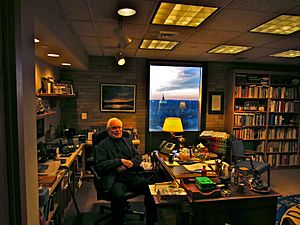
The university's president is always a priest from the Congregation of Holy Cross. The first president was Edward Sorin. The current president, as of June 2024, is Robert A. Dowd. John McGreevy is the provost, who oversees all academic activities.
Until 1967, the Congregation of Holy Cross directly ran Notre Dame. Then, under President Theodore Hesburgh, two groups were created to govern the university: the Board of Fellows and the Board of Trustees. The Fellows have the final say on how the university operates, and the Trustees elect the president and guide the university.
University Funds
Notre Dame's financial fund, called an endowment, started in the early 1920s. By 1952, it was $7 million. By 2023, the university reported its total endowment was $16.62 billion.
Academics and Learning
Colleges and Schools
- The College of Arts and Letters was the first college at the university, started in 1842. It offers degrees in fine arts, humanities, and social sciences. It is the largest college at Notre Dame.
- The College of Science began in 1865. It offers Bachelor of Science degrees in many departments. Its program for students who want to go to medical school has one of the highest acceptance rates in the U.S.
- The Notre Dame Law School started in 1869 and is the oldest law program at a Catholic university in the United States. It offers law degrees and is highly ranked.
- The School of Architecture was established in 1899. Students in this program spend their third year studying in Rome. The school teaches traditional and classical architecture.
- The College of Engineering was created in 1920. It offers degrees in various engineering fields.
- The Mendoza College of Business was established in 1921. It offers degrees in accounting, finance, management, and marketing. Its undergraduate program has been ranked among the best in the country.
- The Keough School of Global Affairs was the first new school at Notre Dame in almost a century, started in 2014. It focuses on global issues like peace studies and sustainable development.
Special Programs
Every new Notre Dame student starts in the First Year of Studies program. This program helps freshmen choose their classes and decide on a major. It also offers tutoring and academic support. There is also an Honors Program for top students in Arts and Letters and Science, offering smaller classes and funding for research.
Advanced Degrees
Each college offers advanced degrees, like master's and doctoral programs. For example, the College of Arts and Letters offers PhDs, and the College of Business offers MBA programs. Notre Dame also has a program where students can earn a Master of Education while teaching in Catholic schools.
Although Notre Dame does not have its own medical school, it partners with the Indiana University School of Medicine. This allows students to start their medical education at Notre Dame before moving to the main medical campus.
Research Centers
In 2019, Notre Dame renamed its Center for Ethics and Culture to the de Nicola Center for Ethics and Culture, thanks to a large gift. This center focuses on Catholic moral and intellectual traditions.
The McGrath Institute for Church Life works with Catholic churches and schools to help with religious challenges.
The Joan B. Kroc Institute for International Peace Studies, founded in 1986, focuses on understanding why conflicts happen and how to achieve lasting peace. It offers degrees in peace studies and helps with international policy discussions.
Libraries
The university's main library is the 14-story Theodore M. Hesburgh Library. It was finished in 1963. The Word of Life mural, also known as "Touchdown Jesus," is on the front of the library.
The library system also has smaller libraries for different subjects like Architecture, Chemistry, and Law. A theology library opened in 2015 inside a dorm. With over three million books, Notre Dame's library system is one of the largest in the country.
Admissions and Costs
| Admissions statistics | |
|---|---|
|
2024 entering
classChange vs. 2019 |
|
| Admit rate | 11.1%
(
|
| Yield rate | 62%
(
|
| Test scores middle 50% | |
| SAT Total | 1470-1540
(
|
| ACT Composite | 33–35
(
|
For the fall 2024 class, Notre Dame accepted 3,324 students out of 29,943 applicants, which is an acceptance rate of 11.1 percent. The university has a "need-blind" admission policy for U.S. students, meaning they don't consider a student's ability to pay when deciding whether to admit them. Students came from all 50 states and traveled an average of over 750 miles to Notre Dame.
Tuition for full-time students at Notre Dame in 2023 was $62,693 per year. Room and board (living and food costs) were an extra $17,378 per year for students living on campus. Since Notre Dame is a private university, the tuition is the same for students from Indiana and other states.
University Rankings
| ARWU World | 301–400 |
|---|---|
| THES World | 196 (tie) |
| USNWR National University | 18 |
| Washington Monthly National University | 10 |
| Forbes | 42 |
|
USNWR graduate rankings |
|
|---|---|
| Business | 30 |
| Engineering | 50 |
| Law | 22 |
|
USNWR graduate departmental rankings |
|
|---|---|
| Biological Sciences | 73 |
| Analytical Chemistry | 13 |
| Chemistry | 59 |
| Clinical Psychology | 37 |
| Computer Science | 58 |
| Earth Sciences | 68 |
| Economics | 47 |
| English | 33 |
| Fine Arts | 99 |
| History | 27 |
| Mathematics | 39 |
| Non-profit Business | 5 |
| Logic | 3 |
| Physics | 52 |
| Political Science | 37 |
| Political Theory | 8 |
| Psychology | 60 |
| Sociology | 32 |
In 2022, U.S. News & World Report ranked Notre Dame 9th for "best undergraduate teaching" and tied for 18th overall among "national universities" in the United States. The Mendoza College of Business undergraduate school was ranked tied for 12th best in the U.S. in 2020. Notre Dame is also known for its strong philosophy program.
Former students of Notre Dame tend to earn good salaries. According to PayScale, undergraduate alumni have a median salary of $110,000 in their mid-career. Newsweek also named Notre Dame one of the "25 New Ivies."
Research at Notre Dame
Early professors at Notre Dame, like Joseph Carrier, believed that scientific research could go hand-in-hand with moral and intellectual values. Important early researchers included John Augustine Zahm, who wrote about evolution, and his brother Albert Zahm, who built an early wind tunnel. Jerome Green was the first American to send a wireless message, and Julius Nieuwland did important work that led to the creation of neoprene. The study of nuclear physics began at the university in 1936.
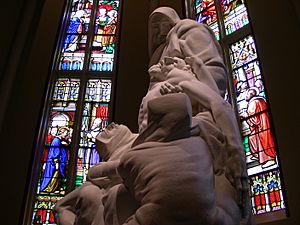
In the 1930s, many Catholic thinkers fled Europe because of dictators like Hitler. President John O'Hara brought many of them to Notre Dame. These scholars, like Anton-Hermann Chroust and Waldemar Gurian, helped develop a strong focus on the dangers of totalitarianism. Ivan Meštrović, a famous sculptor, also came to campus.
Notre Dame has many research centers that combine different subjects. These include the Medieval Institute, the Kellogg Institute for International Studies, and the Kroc Institute for International Peace Studies. Recent research has looked into topics like family conflict, genome mapping, and marketing trends on the Internet. As of 2013, Notre Dame was home to the Notre Dame Global Adaptation Index, which ranks countries on how ready they are for climate change.
In 2019, the university received a record $180.6 million for research. This funding supports projects in areas like diseases, urban planning, cancer, psychology, and physics. Notre Dame is also strong in the humanities, with many fellowships from the National Endowment for the Humanities.
Student Life
| Race and ethnicity | Total | ||
|---|---|---|---|
| White | 68% |
|
|
| Hispanic | 12% |
|
|
| Other | 7% |
|
|
| Asian | 5% |
|
|
| Foreign national | 5% |
|
|
| Black | 3% |
|
|
| Economic diversity | |||
| Low-income | 11% |
|
|
| Affluent | 89% |
|
|
As of Fall 2024, Notre Dame had 8,880 undergraduate students and 4,162 graduate students. About 21–24 percent of students are children of former students. Students come from all 50 states and 88 countries. About 40 percent of U.S. students are students of color, and eight percent are international students.
Living in Residence Halls
The residence halls, or dorms, are a big part of student social life and sports. Each dorm has a rector, who is a full-time leader and guide for the students. Rectors help build a strong community and work with professors and counselors to support students. They also hire student leaders called resident assistants. Many dorms also have a priest or professor living there to offer extra academic and intellectual support. Every dorm has its own chapel where Catholic Mass is celebrated often.
Fraternities and sororities are not allowed on campus because the university believes they go against its mission. The dorms provide a similar social experience but focus on inclusion and do not allow hazing.
Most students live in the same dorm for at least three years. A new policy started in 2018 requires undergraduates to live on campus for three years. Most intramural (interhall) sports are played between dorm teams. Notre Dame is the only non-military academy to offer full-contact intramural American football. The championship game for interhall football is played in Notre Dame Stadium.
Student Clubs and Activities
Notre Dame has over 400 active student clubs. The university helps fund these clubs. There are clubs for students from different states and countries, and clubs focused on Catholic faith, other religions, community service, politics, sports, performing arts, and many other interests. The university holds a Student Activities Fair each fall for students to learn about and join clubs.
Student Government
The Notre Dame Student Union is divided into nine parts, as described in its constitution.
Student Senate
The Student Senate is the group that makes rules and shares the undergraduate students' views on campus life. It has representatives from each dorm and other parts of the Student Union.
Executive Cabinet
This group is led by the Student Body President and Vice President. Its members lead different departments and work to protect student interests, provide services, and advance the Student Union's goals.
Student Union Board
The Student Union Board (SUB) plans events and services for undergraduate students. It has several committees that organize things like concerts and community events.
Hall Presidents Council
The Hall Presidents Council (HPC) plans and funds events for the residence halls. It includes leaders from all the undergraduate dorms.
Club Coordination Council
The Club Coordination Council (CCC) helps student clubs with their issues, provides funding, and makes sure clubs work together. It oversees about 400 student clubs.
Class Councils
There are four Class Councils, one for each undergraduate year (First-Year, Sophomore, Junior, Senior). They plan events to bring their class members together.
Off-Campus Council
This council represents undergraduate students who live off campus and addresses their specific needs.
Financial Management Board
The Financial Management Board (FMB) creates and manages the Student Union's budget. It holds hearings to make sure student funds are given out fairly.
Judicial Council
The Judicial Council oversees the ethical behavior of student leaders, makes sure the Student Union follows its rules, runs elections, and helps students with university conduct hearings.
Student Events
BestColleges.com ranked Notre Dame's intramural sports program as number one in the country in 2021. Over 700 teams play in the annual Bookstore Basketball tournament. The Notre Dame Men's Boxing Club hosts the annual Bengal Bouts tournament to raise money for Holy Cross Missions in Bangladesh. The Notre Dame Women's Boxing Club hosts the Baraka Bouts tournament to raise money for Holy Cross Missions in Uganda.
Many popular student events are organized by the 30 residence halls. Some famous ones include the Keenan Revue, the Fisher Hall Regatta, and the Dillon Hall Pep Rally. Each dorm also hosts dances and formal events.
Religious Life
While students don't have to be religious to attend, over 93 percent of students identify as Christian, and over 80 percent of those are Catholic. There are 57 chapels on campus, including one in every dorm. Catholic Mass is celebrated over 100 times a week on campus. There is also an active Knights of Columbus council, which is the oldest and largest college council of this Catholic men's organization. Non-Catholic religious groups on campus include the Baptist Collegiate Ministry, Jewish Club, Muslim Student Association, and Orthodox Christian Fellowship.
Notre Dame is an important center for the Congregation of Holy Cross. Its main seminary, Moreau Seminary, is on campus. Retired priests and brothers live in Fatima House, Holy Cross House, and Columba Hall.
Student Media
Notre Dame students run nine media outlets: three newspapers, a radio and television station, and several magazines and journals.
The Scholastic magazine, started in 1876, is published twice a month and is one of the oldest college publications in the U.S. The Juggler magazine focuses on student writing and art. The Dome yearbook is published every year.
The Observer newspaper is published daily and reports on university news. It is run by students from Notre Dame and Saint Mary's College. The Irish Rover is another newspaper, published twice a month, that features columns from former students and professors.
WSND-FM is a radio station that plays classical music, fine arts, and alternative rock. Another radio station, WVFI, streams online. The television station NDtv started with one show in 2002 and became a full 24-hour channel with original programming by 2006.
Athletics and Sports
Notre Dame's sports teams are called the Fighting Irish. They compete in NCAA Division I. Most sports teams play in the Atlantic Coast Conference (ACC), except for football and men's ice hockey. Men's ice hockey plays in the Big Ten conference. Notre Dame has teams for men's baseball, basketball, cross country, fencing, football, golf, ice hockey, lacrosse, soccer, swimming and diving, tennis, and track and field. Women's sports include basketball, cross country, fencing, golf, lacrosse, rowing, soccer, softball, swimming and diving, tennis, track and field, and volleyball. The football team plays independently, meaning it's not part of a conference for football, but it plays five games each season against ACC teams.
The nickname "Fighting Irish" was used in the early 1920s for the football team. Notre Dame's official colors are gold and navy blue. Green is sometimes worn because of the "Fighting Irish" nickname.
The Notre Dame Leprechaun is the mascot for the sports teams. It was created in 1964. Fighting Irish Media (FIM) films almost all Fighting Irish sporting events for live broadcasts. In 2014, Notre Dame signed a big deal with Under Armour for uniforms and equipment.
Football Team
The Notre Dame football team started in 1887. Since then, 11 Fighting Irish teams have won national championships. The program has the most members in the College Football Hall of Fame. It is tied for the most Heisman Trophies won by players and has one of the highest winning percentages in NCAA history. Notre Dame has many rivals, and the annual game against USC is one of the biggest in college football.
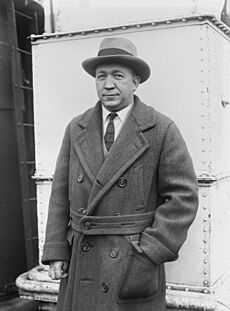
George Gipp was a legendary football player in the late 1910s. In 1928, coach Knute Rockne used his last conversation with the dying Gipp to inspire the Notre Dame team to beat Army and "win one for the Gipper." This moment became famous in the 1940 movie Knute Rockne, All American.
The team plays in the 80,795-seat Notre Dame Stadium. The current head coach is Marcus Freeman, who became coach at the end of the 2021 regular season. The Notre Dame football program is very valuable, with a TV contract with NBC.
Football Game-Day Traditions
On home game days, there are many activities around campus. Dorms decorate their halls with special signs. The Drummers' Circle starts at midnight with the Band of the Fighting Irish's drumline. Later, the trumpet section plays the Notre Dame Victory March and the Alma Mater under the dome. The entire band plays a concert and then marches into the stadium, leading fans to the game. At the end of each game, the band plays the alma mater.
- Football gameday traditions
-
The Band of the Fighting Irish plays inside Notre Dame Stadium.
-
The Band of the Fighting Irish spells out ND through which the Notre Dame Fighting Irish Football Team runs onto the field.
Men's Basketball
As of the 2020–2021 season, the men's basketball team has over 1,910 wins and has played in 36 NCAA tournaments. Former player Austin Carr holds the record for most points scored in a single tournament game with 61. The team has never won the NCAA Tournament, but they have beaten many top-ranked teams. One famous win was ending UCLA's record 88-game winning streak in 1974.
Other Sports
Notre Dame has won 15 national championships in sports other than football. The fencing team has won 10, and the men's lacrosse, men's tennis, and women's soccer teams have each won two. The men's cross country and golf teams have won one, and Notre Dame women's basketball has won two.
Band and Fight Song
The Band of the Fighting Irish was formed in 1846 and is the oldest university band that has continuously existed. The marching band plays at home games for most sports. It regularly plays the school's fight song, the Notre Dame "Victory March." This song is known as the most played and most famous fight song. It was honored as a "Landmark of American Music" during the United States Bicentennial. The song is featured in movies like Knute Rockne, All American, Airplane!, and Rudy.
Famous Alumni
Notre Dame has over 130,000 former students, called alumni, and 275 alumni clubs around the world. Notre Dame is known for having one of the strongest alumni networks. Many alumni donate money to the university each year. Many buildings on campus are named after major donors.
Alumni who have worked in politics include state governors, members of the United States Congress, and former United States Secretary of State Condoleezza Rice. Famous alumni from the College of Science include Eric F. Wieschaus, who won the 1995 Nobel Prize in medicine, and Philip Majerus, who discovered the heart-protecting effects of aspirin. Many university officials are alumni, including the current president, Robert Dowd.
Alumni in media include talk show hosts Regis Philbin and Phil Donahue, and TV and radio personalities like Mike Golic and Hannah Storm. Many sports alumni have become professional athletes, such as Joe Montana, Tim Brown, Ruth Riley, Jeff Samardzija, and Olympic fencing gold medalist Mariel Zagunis. Other notable alumni include businessman Edward J. DeBartolo Jr. and astronaut Jim Wetherbee. Two alumni have received the Presidential Medal of Freedom and two the Congressional Gold Medal.
See also
 In Spanish: Universidad de Notre Dame para niños
In Spanish: Universidad de Notre Dame para niños
- Notre Dame Shakespeare Festival, held on campus every summer


